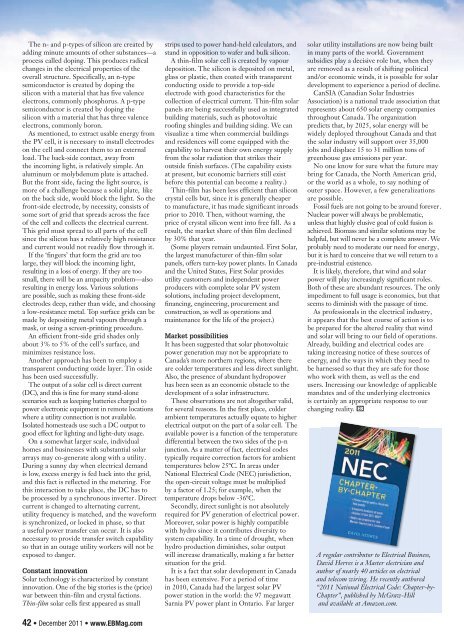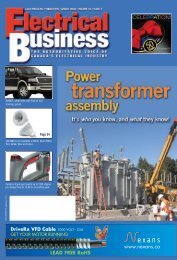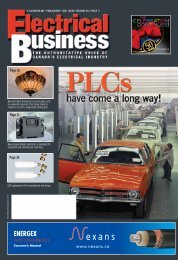DECEMBER 2011 - Electrical Business Magazine
DECEMBER 2011 - Electrical Business Magazine
DECEMBER 2011 - Electrical Business Magazine
You also want an ePaper? Increase the reach of your titles
YUMPU automatically turns print PDFs into web optimized ePapers that Google loves.
The n- and p-types of silicon are created by<br />
adding minute amounts of other substances—a<br />
process called doping. This produces radical<br />
changes in the electrical properties of the<br />
overall structure. Specifically, an n-type<br />
semiconductor is created by doping the<br />
silicon with a material that has five valence<br />
electrons, commonly phosphorus. A p-type<br />
semiconductor is created by doping the<br />
silicon with a material that has three valence<br />
electrons, commonly boron.<br />
As mentioned, to extract usable energy from<br />
the PV cell, it is necessary to install electrodes<br />
on the cell and connect them to an external<br />
load. The back-side contact, away from<br />
the incoming light, is relatively simple. An<br />
aluminum or molybdenum plate is attached.<br />
But the front side, facing the light source, is<br />
more of a challenge because a solid plate, like<br />
on the back side, would block the light. So the<br />
front-side electrode, by necessity, consists of<br />
some sort of grid that spreads across the face<br />
of the cell and collects the electrical current.<br />
This grid must spread to all parts of the cell<br />
since the silicon has a relatively high resistance<br />
and current would not readily flow through it.<br />
If the ‘fingers’ that form the grid are too<br />
large, they will block the incoming light,<br />
resulting in a loss of energy. If they are too<br />
small, there will be an ampacity problem—also<br />
resulting in energy loss. Various solutions<br />
are possible, such as making these front-side<br />
electrodes deep, rather than wide, and choosing<br />
a low-resistance metal. Top surface grids can be<br />
made by depositing metal vapours through a<br />
mask, or using a screen-printing procedure.<br />
An efficient front-side grid shades only<br />
about 3% to 5% of the cell’s surface, and<br />
minimizes resistance loss.<br />
Another approach has been to employ a<br />
transparent conducting oxide layer. Tin oxide<br />
has been used successfully.<br />
The output of a solar cell is direct current<br />
(DC), and this is fine for many stand-alone<br />
scenarios such as keeping batteries charged to<br />
power electronic equipment in remote locations<br />
where a utility connection is not available.<br />
Isolated homesteads use such a DC output to<br />
good effect for lighting and light-duty usage.<br />
On a somewhat larger scale, individual<br />
homes and businesses with substantial solar<br />
arrays may co-generate along with a utility.<br />
During a sunny day when electrical demand<br />
is low, excess energy is fed back into the grid,<br />
and this fact is reflected in the metering. For<br />
this interaction to take place, the DC has to<br />
be processed by a synchronous inverter. Direct<br />
current is changed to alternating current,<br />
utility frequency is matched, and the waveform<br />
is synchronized, or locked in phase, so that<br />
a useful power transfer can occur. It is also<br />
necessary to provide transfer switch capability<br />
so that in an outage utility workers will not be<br />
exposed to danger.<br />
Constant innovation<br />
Solar technology is characterized by constant<br />
innovation. One of the big stories is the (price)<br />
war between thin-film and crystal factions.<br />
Thin-film solar cells first appeared as small<br />
strips used to power hand-held calculators, and<br />
stand in opposition to wafer and bulk silicon.<br />
A thin-film solar cell is created by vapour<br />
deposition. The silicon is deposited on metal,<br />
glass or plastic, then coated with transparent<br />
conducting oxide to provide a top-side<br />
electrode with good characteristics for the<br />
collection of electrical current. Thin-film solar<br />
panels are being successfully used as integrated<br />
building materials, such as photovoltaic<br />
roofing shingles and building siding. We can<br />
visualize a time when commercial buildings<br />
and residences will come equipped with the<br />
capability to harvest their own energy supply<br />
from the solar radiation that strikes their<br />
outside finish surfaces. (The capability exists<br />
at present, but economic barriers still exist<br />
before this potential can become a reality.)<br />
Thin-film has been less efficient than silicon<br />
crystal cells but, since it is generally cheaper<br />
to manufacture, it has made significant inroads<br />
prior to 2010. Then, without warning, the<br />
price of crystal silicon went into free fall. As a<br />
result, the market share of thin film declined<br />
by 30% that year.<br />
(Some players remain undaunted. First Solar,<br />
the largest manufacturer of thin-film solar<br />
panels, offers turn-key power plants. In Canada<br />
and the United States, First Solar provides<br />
utility customers and independent power<br />
producers with complete solar PV system<br />
solutions, including project development,<br />
financing, engineering, procurement and<br />
construction, as well as operations and<br />
maintenance for the life of the project.)<br />
Market possibilities<br />
It has been suggested that solar photovoltaic<br />
power generation may not be appropriate to<br />
Canada’s more northern regions, where there<br />
are colder temperatures and less direct sunlight.<br />
Also, the presence of abundant hydropower<br />
has been seen as an economic obstacle to the<br />
development of a solar infrastructure.<br />
These observations are not altogether valid,<br />
for several reasons. In the first place, colder<br />
ambient temperatures actually equate to higher<br />
electrical output on the part of a solar cell. The<br />
available power is a function of the temperature<br />
differential between the two sides of the p-n<br />
junction. As a matter of fact, electrical codes<br />
typically require correction factors for ambient<br />
temperatures below 25ºC. In areas under<br />
National <strong>Electrical</strong> Code (NEC) jurisdiction,<br />
the open-circuit voltage must be multiplied<br />
by a factor of 1.25; for example, when the<br />
temperature drops below -36ºC.<br />
Secondly, direct sunlight is not absolutely<br />
required for PV generation of electrical power.<br />
Moreover, solar power is highly compatible<br />
with hydro since it contributes diversity to<br />
system capability. In a time of drought, when<br />
hydro production diminishes, solar output<br />
will increase dramatically, making a far better<br />
situation for the grid.<br />
It is a fact that solar development in Canada<br />
has been extensive. For a period of time<br />
in 2010, Canada had the largest solar PV<br />
power station in the world: the 97 megawatt<br />
Sarnia PV power plant in Ontario. Far larger<br />
solar utility installations are now being built<br />
in many parts of the world. Government<br />
subsidies play a decisive role but, when they<br />
are removed as a result of shifting political<br />
and/or economic winds, it is possible for solar<br />
development to experience a period of decline.<br />
CanSIA (Canadian Solar Industries<br />
Association) is a national trade association that<br />
represents about 650 solar energy companies<br />
throughout Canada. The organization<br />
predicts that, by 2025, solar energy will be<br />
widely deployed throughout Canada and that<br />
the solar industry will support over 35,000<br />
jobs and displace 15 to 31 million tons of<br />
greenhouse gas emissions per year.<br />
No one know for sure what the future may<br />
bring for Canada, the North American grid,<br />
or the world as a whole, to say nothing of<br />
outer space. However, a few generalizations<br />
are possible.<br />
Fossil fuels are not going to be around forever.<br />
Nuclear power will always be problematic,<br />
unless that highly elusive goal of cold fusion is<br />
achieved. Biomass and similar solutions may be<br />
helpful, but will never be a complete answer. We<br />
probably need to moderate our need for energy,<br />
but it is hard to conceive that we will return to a<br />
pre-industrial existence.<br />
It is likely, therefore, that wind and solar<br />
power will play increasingly significant roles.<br />
Both of these are abundant resources. The only<br />
impediment to full usage is economics, but that<br />
seems to diminish with the passage of time.<br />
As professionals in the electrical industry,<br />
it appears that the best course of action is to<br />
be prepared for the altered reality that wind<br />
and solar will bring to our field of operations.<br />
Already, building and electrical codes are<br />
taking increasing notice of these sources of<br />
energy, and the ways in which they need to<br />
be harnessed so that they are safe for those<br />
who work with them, as well as the end<br />
users. Increasing our knowledge of applicable<br />
mandates and of the underlying electronics<br />
is certainly an appropriate response to our<br />
changing reality.<br />
A regular contributor to <strong>Electrical</strong> <strong>Business</strong>,<br />
David Herres is a Master electrician and<br />
author of nearly 40 articles on electrical<br />
and telecom wiring. He recently authored<br />
“<strong>2011</strong> National <strong>Electrical</strong> Code: Chapter-by-<br />
Chapter”, published by McGraw-Hill<br />
and available at Amazon.com.<br />
42 • December <strong>2011</strong> • www.EBMag.com

















